The purveyors of climate alarm posit that rising CO2 emissions cause up to 600% increases in burned area due to global warming. Newly published science thoroughly undermines these claims. Observational evidence affirms global-scale fire frequencies and burned area have actually been declining for decades (especially since the early 1900s), with overall biomass burning lower today than during the much colder Little Ice Age.
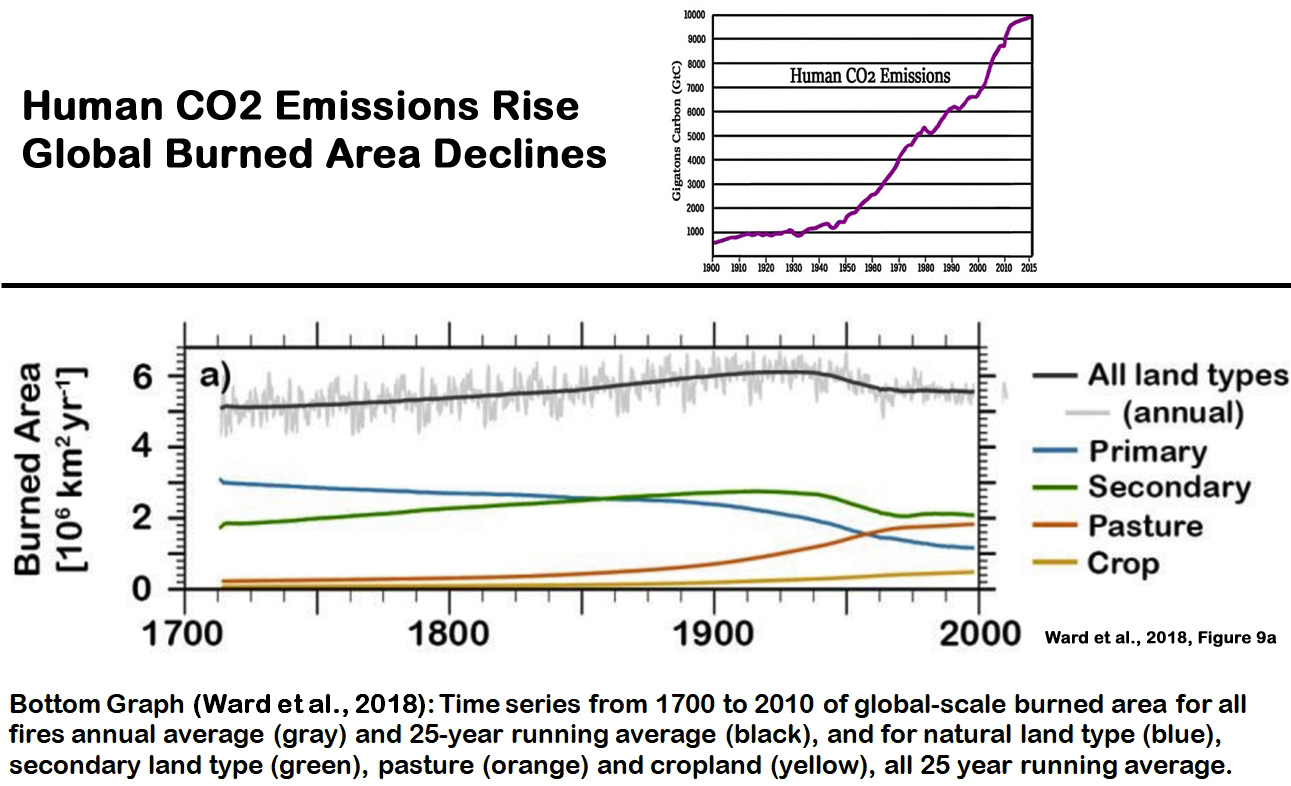
Bottom Graph Source: Ward et al., 2018
On a global scale, fire emissions/burned area peaked in the 1910s, but then plummeted to “about 5% below year 1700 levels by 2010” (Ward et al., 2018).
The decreasing trend in wildfires has continued unabated in the 21st century, as there has been “a strong statistically significant decline in 2001–2016 active fires globally” (Earl and Simmonds, 2018).
On a long-term scale, “global biomass burning during the past century has been lower than at any time in the past 2000 years” (Doerr and Santín, 2016).
Even in the Western United States, where wildfires are currently ravaging the landscape, there has been a “decline in burning over the past 3,000 y[ears], with the lowest levels attained during the 20th century and during the Little Ice Age (LIA, ca. 1400–1700 CE)” (Marlon et al., 2012).
The perception of increasing fire occurrence vs. the observations of decreasing trends
Doerr and Santín (2016) characterize the association between global warming and increases in wildfires as a “perception” spawned by using selective regional data and short timescales (in other words, by excluding contradictory evidence). The alarming conclusions that wildfires are worsening due to rising anthropogenic CO2 emissions are then promulgated by mainstream media.
“Numerous reports, ranging from popular media through to peer-reviewed scientific literature, have led to a common perception
that fires have increased or worsened in recent years around the world. Where these reports are accompanied by quantitative observations, they are often based on short timescales and regional data for fire incidence or area burned, which do not necessarily reflect broader temporal or spatial realities.”
To summarize, there are “widely held perceptions both in the media and scientific papers of increasing fire occurrence, severity and resulting losses“, and yet “the quantitative evidence available does not support these perceived overall trends” (Doerr and Santín, 2016).
Ward et al., 2018
Trends and Variability of Global Fire Emissions
Due To Historical Anthropogenic Activities
“Globally, fires are a major source of carbon from the terrestrial biosphere to the atmosphere, occurring on a seasonal cycle and with substantial interannual variability. To understand past trends and variability in sources and sinks of terrestrial carbon, we need quantitative estimates of global fire distributions. … Global fire emissions of carbon increase by about 10% between 1700 and 1900, reaching a maximum of 3.4 Pg C yr−1 in the 1910s, followed by a decrease to about 5% below year 1700 levels by 2010. The decrease in emissions from the 1910s to the present day is driven mainly by land use change, with a smaller contribution from increased fire suppression due to increased human population and is largest in Sub‐Saharan Africa and South Asia. Interannual variability of global fire emissions is similar in the present day as in the early historical period, but present‐day wildfires would be more variable in the absence of land use change.”
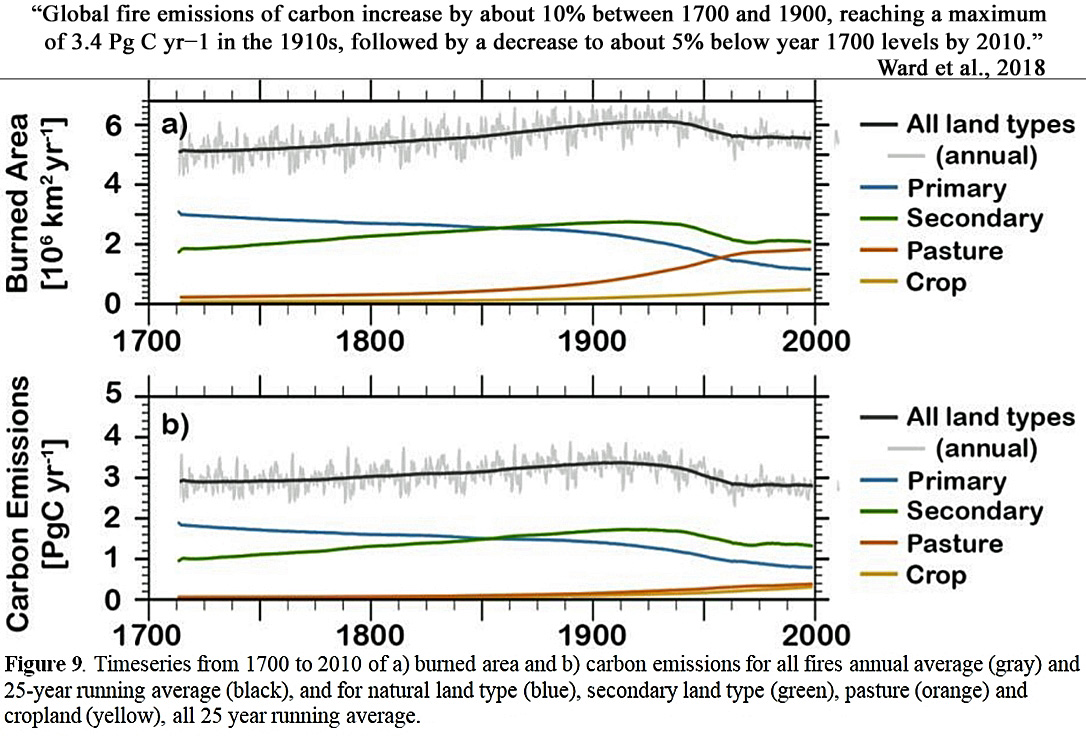
Earl and Simmonds, 2018
Spatial and Temporal Variability and
Trends in 2001–2016 Global Fire Activity
“We find that there is a strong statistically significant decline in 2001–2016 active fires globally linked to an increase in net primary productivity observed in northern Africa, along with global agricultural expansion and intensification, which generally reduces fire activity.”
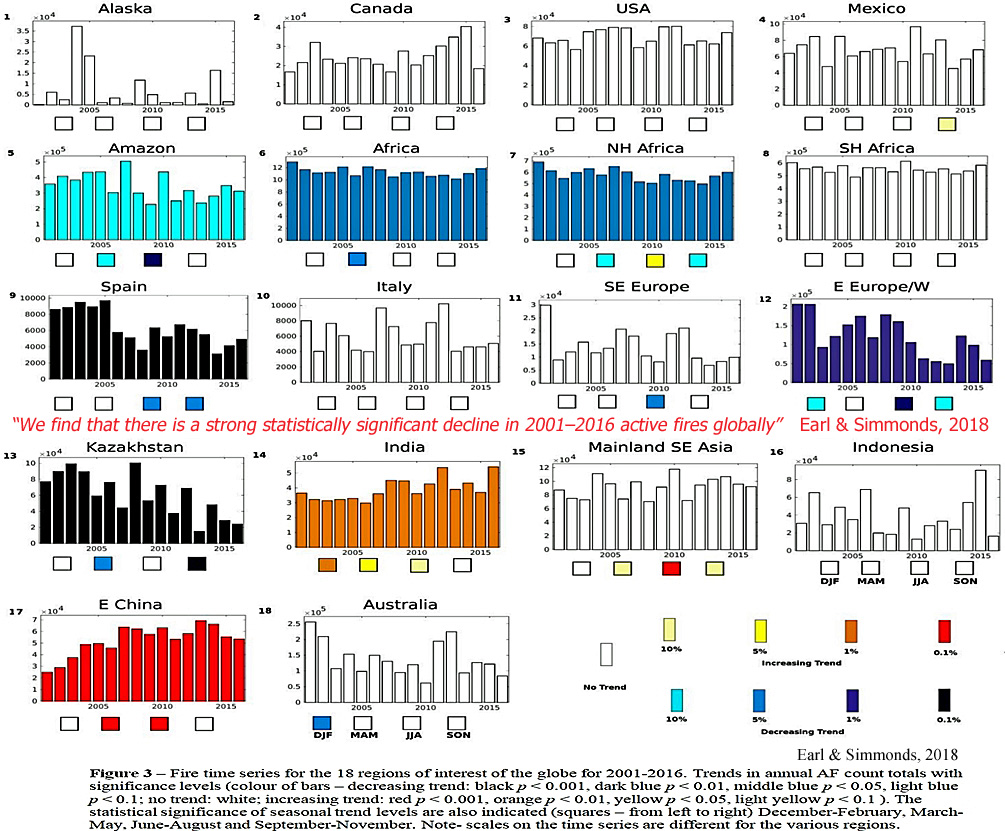
Doerr and Santín, 2016
Global trends in wildfire and its impacts:
perceptions versus realities in a changing world
“Wildfire has been an important process affecting the Earth’s surface and atmosphere for over 350 million years and human societies have coexisted with fire since their emergence. Yet many consider wildfire as an accelerating problem, with widely held perceptions both in the media and scientific papers of increasing fire occurrence, severity and resulting losses.”
“However, important exceptions aside, the quantitative evidence available does not support these perceived overall trends. Instead, global area burned appears to have overall declined over past decades, and there is increasing evidence that there is less fire in the global landscape today than centuries ago.”
“Analysis of charcoal records in sediments [Marlon et al., 2008] and isotope-ratio records in ice cores [Wang et al., 2010] suggest that global biomass burning during the past century has been lower than at any time in the past 2000 years.”
“Regarding fire severity, limited data are available. For the western USA, they indicate little change overall, and also that area burned at high severity has overall declined compared to pre-European settlement. Direct fatalities from fire and economic losses also show no clear trends over the past three decades. Trends in indirect impacts, such as health problems from smoke or disruption to social functioning, remain insufficiently quantified to be examined. Global predictions for increased fire under a warming climate highlight the already urgent need for a more sustainable coexistence with fire. The data evaluation presented here aims to contribute to this by reducing misconceptions and facilitating a more informed understanding of the realities of global fire.”
Marlon et al., 2012
Long-term perspective on
wildfires in the western USA
“Understanding the causes and consequences of wildfires in forests of the western United States requires integrated information about fire, climate changes, and human activity on multiple temporal scales. We use sedimentary charcoal accumulation rates to construct long-term variations in fire during the past 3,000 y in the American West and compare this record to independent fire-history data from historical records and fire scars. There has been a slight decline in burning over the past 3,000 y, with the lowest levels attained during the 20th century and during the Little Ice Age (LIA, ca. 1400–1700 CE). Prominent peaks in forest fires occurred during the Medieval Climate Anomaly (ca. 950–1250 CE) and during the 1800s.”
“Analysis of climate reconstructions beginning from 500 CE and population data show that temperature and drought predict changes in biomass burning up to the late 1800s CE. Since the late 1800s , human activities and the ecological effects of recent high fire activity caused a large, abrupt decline in burning similar to the LIA fire decline. Consequently, there is now a forest “fire deficit” in the western United States attributable to the combined effects of human activities, ecological, and climate changes. Large fires in the late 20th and 21st century fires have begun to address the fire deficit, but it is continuing to grow.”
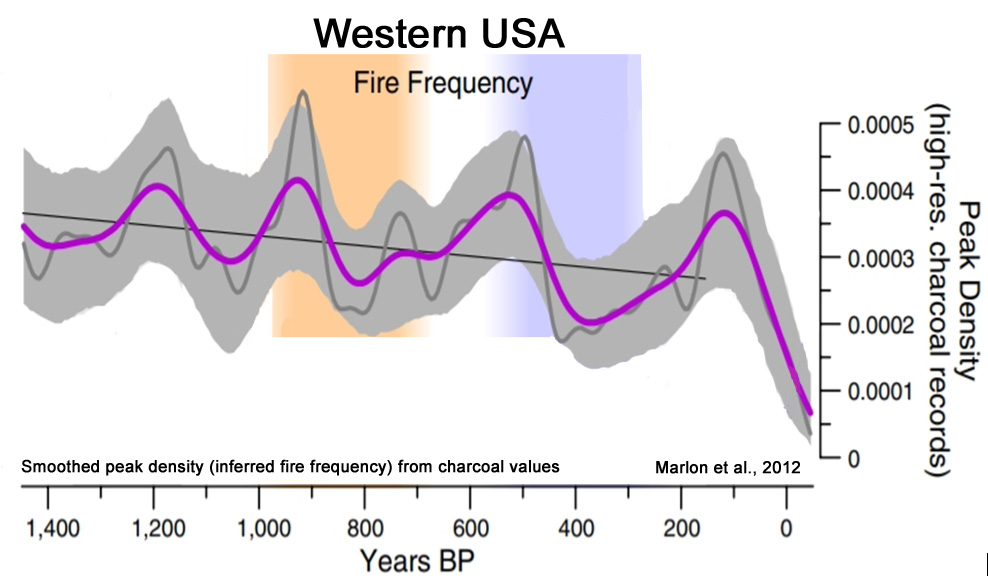
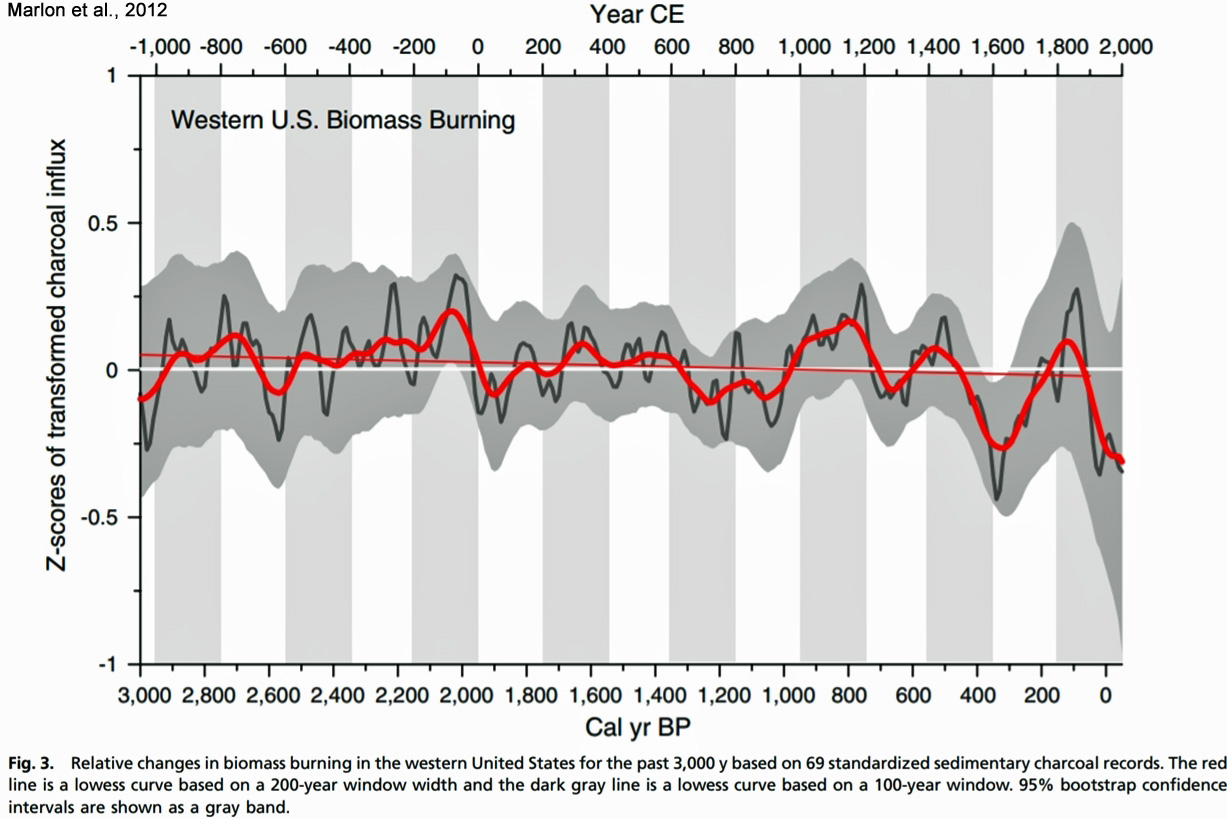





More “settled science”?
And the whole basis for the false expectation of increased fire risk is based on the false claim that temperatures have risen or will rise catastrophically due to human production of CO2.
Problem is, nothing could be further from the truth.
“The case for the catastrophic anthropogenic global warming hypothesis is so poor, that it is clear that the real reason so many support this false hypothesis does not lie in the science. There are ulterior political and unethical business motives for the constant claims that man’s use of fossil fuels is going to be responsible for a global climate catastrophe.”
https://objectivistindividualist.blogspot.com/2010/05/false-catastrophic-man-made-global.html
If that is not climate denial then what is it? Do the others here support that statement?
On top of that, this guy is going into full conspiracy theorist mode … a great demonstration of what “skeptics” really are.
What that is: Another example of your intellectual dishonesty. You ripped a quote from its full context (and then emboldened it) to make Yonason appear to say something he did not. He did not write that temperatures have not risen. He wrote that it is a false claim that temperatures have risen “due to the human production of CO2”. You purposely truncated what he wrote so that you could write about “climate denial” – whatever that is.
The full quote/context, unbutchered:
“And the whole basis for the false expectation of increased fire risk is based on the false claim that temperatures have risen or will rise catastrophically due to human production of CO2.”
Provide hard, measurable, observable evidence that human CO2 emissions are what controls the temperatures of the World Ocean. Don’t have any? (And, of course, you don’t.) Then you have no leg to stand on when claiming that Yonason is a “denier” of the belief that temperatures have risen because of anthropogenic CO2 emissions. We are skeptics. We need cause-effect measurements and observational evidence to become believers in the human control over ocean water temperatures, glacier melt, sea level rise, etc.
You are right, I purposely truncated. I was going to cut it before the “or” but thought it would be more subtle this way.
You can interpret that however you want (“Another example of your intellectual dishonesty.”) … I call it eating your own dog food. I might add that you are excluded here. It’s specifically for Yonason and the other words-in-mouth-twisters. The usual suspects will, of course, be oblivious to this kind of trolling … and yeah, THAT was trolling.
Every “hard, measurable, observable evidence” points to CO2. You chose to search for “evidence” that supports your viewpoint. And that’s ok. But it doesn’t make your viewpoint any more realistic. You are constructing yourself a world where denying the obvious feels like being the hero. Being skeptic you call it. Nope, you are not skeptic. If you were you would not post (from time to time) papers that are outright junk and claim that they would somehow support a skeptical viewpoint. You are not skeptic about those papers or authors … not a bit.
You don’t need anything to believe in anything that supports your viewpoint. Think about that for a while and then come back and explain why you will still continue to call yourself a skeptic. Thanks.
Q1. In what way has the climate changed in the last 40 years, that can be scientifically attributable to human CO2 ?
Q2. Do you have ANY EMPIRICAL EVIDENCE at all that humans have changed the global climate in ANYWAY WHATSOEVER?
Its YOUR fantasy, seb.
PRODUCE THE EVIDENCE
Stop your headless chook ducking and weaving,
or just keep RUNNING AWAY.
You have yet to answer the blog post showing indication of DECLINING fires.
Snicker…………………..
“The usual suspects will, of course, be oblivious to this kind of trolling “
NO, not oblivious.
We see it in EVERY one of your posts.
Noted again that refuse to PRODUCE THE EVIDENCE for CO2 causing warming
You KNOW you don’t have any, so evasion is your only course of action.
Your posts are an irrelevance to rational discussion.
Q1. In what way has the climate changed in the last 40 years, that can be scientifically attributable to human CO2 ?
Q2. Do you have ANY EMPIRICAL EVIDENCE at all that humans have changed the global climate in ANYWAY WHATSOEVER?
cue another seb rant, producing ZERO evidence.. as always.
Oh. Yes, “eating your own dog food” (?) is probably is a bit more euphemistic than “I engaged in intellectual dishonesty by purposely misrepresenting what someone else wrote.”
Great. Then you should have no difficulty citing these cause-effect measurements involving CO2 concentration changes and water temperature changes. Show us what you have.
No, not really. Just highlighting scientific papers that undermine cherished beliefs about CO2 as a climate regulator.
Speaking of, just a few days ago you claimed that increases in temperature cause more wildfire burned area across the globe. This article you’re commenting in contradicts those claims. Do you have counter evidence that you can cite to support your beliefs?
“I call it eating your own dog food.”
In your case its eating your own BS. !
You are an evidence free zone, seb
Q1. In what way has the climate changed in the last 40 years, that can be scientifically attributable to human CO2 ?
Q2. Do you have ANY EMPIRICAL EVIDENCE at all that humans have changed the global climate in ANYWAY WHATSOEVER?
Thank you, Kenneth. You got my meaning, just as SebH did, except that he chose to distort it, AS USUAL.
GW nailed his behavior, here. (as have you, but I can’t find yours at the moment)
“Their M.O is:
1) Always have the last word.
2) Never admit they’re wrong.
3) Portray themselves as the teacher and you the student.
4) Do whatever they can to undermine confidence in their opponent (their person rather than their argument).
5) Always misrepresent their opponents position.”
Yep. That’s SebH, all right. Dependable repeat offender. So predictable.
Thank you for providing that link. I beginning to see now that we are running in circles here. I bet nothing has changed from back then and Kenneth still thinks that I am “believing” that CO2 re-radiates unidirectional towards the surface.
A fun quote from back then (author GW):
That described very well what skeptics will do if you aren’t exact with your words, only he thought I would do that. Kenneth is doing it regularly now, you guys do it too. And seriously, you guys aren’t finding yourselves in that description GW? You know … that part before the one you quoted here?
You recognize he didn’t write about one side exclusively, right?
Yonason, your assessment is quite correct but I would add…
As SebastianH shows with his last comment at me “Your interpretation of science has no value to me.” he is an intellectual midget but a vast egotistical snob!
He believes he can talk down to those he perceives are his inferiors.
Hence his snide comments to Bitter&twisted, spike55, etc, and now me. He just reinforces the fact he is a snob with each comment, a believer in his own intellectual superiority.
He’s not here to teach or learn but (as you say) undermine confidence in opponents, while sermonize on the IPCC religion, and through banal analogies tries to get others to indulge in his intellectual onanism.
@tom0mason 15. August 2018 at 12:41 AM
I think GW’s assessment of him implies what you articulate. So, yes, quite so.
John thinks that Tomasson has it spot on!
John also thinks never argue with a fool because outsiders might not be able to tell the difference.
@John Brown 15. August 2018 at 2:37 AM
Or, as B&T oft repeats, DNFTT!
“a believer in his own intellectual superiority. “
A totally BASELESS assumption on his behalf.
The guy is basically a mindless-chook and a DULLARD, incapable of even the most basic science or scientific comprehension.
His comments indicate a junior high level comprehension of science, physics, maths, biology et al.. at the very best.
Thank you guys for playing. You just demonstrated that the quote from GW is true for this blog … “comes with its own little gang of trolls who all seem to think exactly the same thing, always argue in exactly the same ways, and repeat the exact same lies ad nauseam”
@tomOmason:
you are confused and don’t recognize it. Sorry that you feel like I would be looking down on you. It’s kind of sad that people like you think they understood everything and withdraw in their bubbles … not wanting to hear anything from people outside the bubble.
Spikey,
Whenever you stop that clown routine and we manage to have a normal debate/conversation in this comment section without you insulting everyone you feel threatened by.
Oh spikey, you are the one ranting here. And when did you actually post anything that resembled “evidence”? You can’t be taken serious. Especially since you do this kind of truncating and misrepresentation trolling all the time and now and now claim you “see it in every post” i make. Right … #facepalm
Why? Is this blog now address specially to me? I linked to some “blogscience” that shows – with data – that fires in the U.S. are likely increasing. But hey, it’s blogscience, since it got posted in a blog. Or how did Yonason put it again? Carbonbrief is the devil or something like that. With conversations going like that, what am I supposed to do? You guys are too stubborn and too deep into denial imagining that you are skeptic when in reality you are just opposing mainstream science. That’s all.
Don’t you know what that term means? Oh and, tell the rest to those that actually do it on a regular basis. I’ll notify you when I see it in case you are blind to this when your side does it.
Great, demanding the results for a near impossible experiment again, are we? How about you try to present me cause-effect measurements of gravity on a 100 kg ball of tungsten in an orbit around Sirius. Oh, you can’t? Well, then I can’t accept that gravity works the same everywhere. Sounds familiar? Or will you – again – reply that gravity is something measurable and the CO2 effect isn’t? Well, tell that to the author who’s paper you are regularly citing about the weak GHE in the polar regions 😉
Shall we go back in time and look at the obvious junk papers that you tried to sell as “undermining cherished beliefs”? And why do you keep calling it belief anyway? Trying to establish something here? Like the others here try to do with the unit “Wadham”? Or when they use creative variations of the names of opponents to establish dominance? Is that it?
As written a few paragraphs above, I presented you a link you turned down as “blogscience”. You are now saying that what you wrote in a blog contradicts those claims? I am guessing you haven’t read that carbonbrief.org article … why? Because you “believe” it’s beneath you. The author has a masters degree in environmental science and is completing a PhD in climate science. I am sure that qualifies his writings more than what I could come up with “describing” what is written over there or what you could gather as “evidence”, mr. blogscience.
These papers are not “what I wrote in a blog”. These are peer-reviewed scientific papers that say global-scale (not just the U.S. West) fire frequency and burned area have been declining for decades, including the 2000-2016 period, and are now lower than they were during the Little Ice Age. This contradicts the claim that a 1 degree increase in air temperature causes 600% more burned area…in the Western U.S. Do you have evidence to present that global-scale trends in fire frequency/burned area are on the rise relative to the Little Ice Age No? Then why not acknowledge that your claim that global air temperature warming causes more burned area is not supported by scientific evidence?
And seb RANT, but PRODUCES NO EVIDENCE,
Carrying on like a demented headless chook.
Just attention seeking trolling !!
EMPTY AS ALWAYS
“cue another seb rant, producing ZERO evidence.. as always.”
Right on cue.
So predictable 🙂
and so, so EMPTY of any scientific evidence
“everyone you feel threatened by.”
ROFLMAO… how much more puerile and idiotic can you get (I bet you will keep trying)
Poor seb, I do not feel the least bit threatened by you or anything you say.
You see, I KNOW there is no scientific evidence of atmospheric CO2 warming anything,
… so I KNOW THAT YOU CAN NEVER PRODUCE ANY.
Your every post PROVES MY CASE. 🙂
Keep going, everyone can see straight through your mindless evasion and bluster. 🙂
Your child-minded and unsupportable arrogance has got the better of you, as always, if you think you are anything more to me than a distant chihuahua yapping.
In the mean time, how about “imagining up” an actual non-cowardly response to two simple questions..
Or just keep up the very scared headless chook routine…
Q1. In what way has the climate changed in the last 40 years, that can be scientifically attributable to human CO2 ?
Q2. Do you have ANY EMPIRICAL EVIDENCE at all that humans have changed the global climate in ANYWAY WHATSOEVER?
The only one ranting with no evidence ever presented is you, spikey. Also lots of insulting language.
Keep running, little cowardly headless chook. 🙂
The only tactic you seem to have left to you.
You have tried lies, deceit, misinformation, misquoting, all of it totally anti-science, and zero-evidence…. and are still batting zero from 10,000 when it comes to actual progress in whatever your pathetic agenda is.
Dig deeper and deeper into your mindless BS, seb, you will find a home somewhere.
Maybe you could try answering these two questions, instead of continually squirming and slithering away from them in childish attempts to distract from your abject inability to present even the slightest scientific evidence.
Q1. In what way has the climate changed in the last 40 years, that can be scientifically attributable to human CO2 ?
Q2. Do you have ANY EMPIRICAL EVIDENCE at all that humans have changed the global climate in ANYWAY WHATSOEVER?
How about conversing like an adult for once, spike55. That would be new. Are you acting like this in real life too?
STUPID STUFF YOU JUST CAN’T MAKE UP
“California’s Biggest Utility Continues To Blame Global Warming For Wildfires Started By Its Own Power Lines”
http://dailycaller.com/2018/08/13/california-utility-global-warming-fires/
“Faced with that sort of liability, Williams is racing to save her company and her job. Democratic California Gov. Jerry Brown and some state lawmakers have embraced the idea. (RELATED: Humans, Not Global Warming, Sparked Almost All Of California’s Wildfires: Study)”
Oh, if you are dailycaller.com you can make up any number of “news” stories. It says a lot about someone when he tries to discredit something like carbonbrief.org but regularly posts dailycaller.com links 😉
SebH employs typical activist strategy
Carbon Brief is garbage, not because it’s “Carbon Brief,” but because it’s demonstrably garbage, as I and others have shown in the past.
https://notrickszone.com/2018/08/08/arctic-ice-volume-surges-to-3rd-highest-in-16-years-amm-lowest-since-1972-maue-hits-mann/comment-page-1/#comment-1270487
He dismisses Daily Caller solely because it’s Daily Caller, and not because the information contained in it is wrong, just that he doesn’t like it because it exposes him and the warmists he claims to represent as being profoundly wrong.
That is why SebH’s attack of my source is an ad hom, and my attack on his is not.
Deceit is all they have.
Did a thread vanish here? Or do I remember a conversation that never happened?
Isn’t that the whole point? Fire prevention created far too dense of forests? By keeping fire frequency down, we guaranteed that when there were fires, there would be plenty to burn?
How does the saying go? The road to hell is paved with good intentions? and It’s not nice to fool with Mother Nature?
CO2isLife is correct.
In the USA, fires are mostly caused by actions or activities of humans, and near where those things take place. When possible they are put out or contained quickly. This allows fuel to accumulate.
The forest industry is much reduced in the States and the wooded land is in-filling and accumulating fuel.
However this is bringing on a time when some fires will be very big and about all that can be done is to get out of the way. Where possible, people and structures will be protected.
We know all this. The problem is what to do about it.
See: Era of Mega-Fires”>
Also search on “fire-adapted communities” and “firewise” .
As someone pointed out the other day the only non-human generator of a fire is lightning. The only other that comes close is spontaneous burning in hay of which we have seen a few recently thanks to our unusually prolonged warm spells.
Everything else has mankind’s fingerprints on it somewhere in the process!
More CO2 = more green trees.
More green trees = less bushfires
Steve,
“More CO2 = more green trees.
More green trees = less bushfires”
Over time …
More green trees = more older trees and forest floor litter.
More more older trees and litter = more fuel for fire.
More fuel for fire = more frequent, and/or larger, natural forest fires during hot summers.
Natural forest fires = more forest spaces for new growth.
More spaces for new growth = more green trees (with natural fire breaks) …
Normally most forests over the long term have periods of fire, some of them very large forest fires, within some forests these fires are quite frequent.
With appropriate human intervention the range and frequency of natural forest fires can be altered to reduce these fires.
With inappropriate human intervention the range and frequency of natural forest fires can be altered to increase the effects of these fires.
tomomason
Agreed and well said.
[…] (Source) […]
[…] https://notrickszone.com/2018/08/13/climate-alarm-flames-out-as-scientists-find-global-fires-burned-a… […]